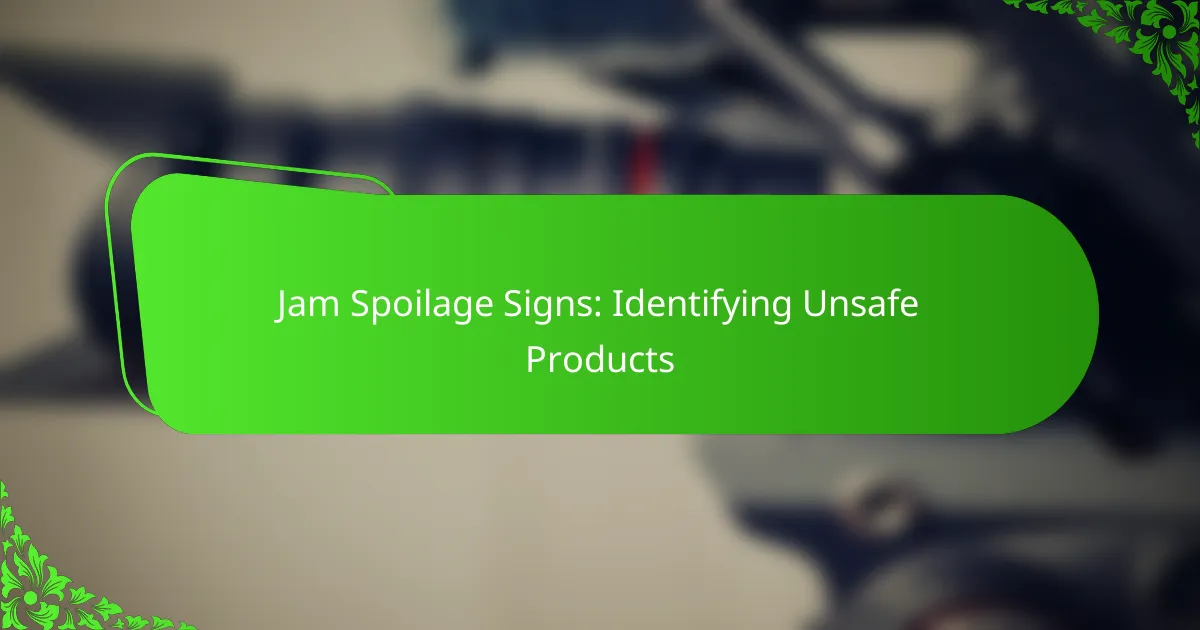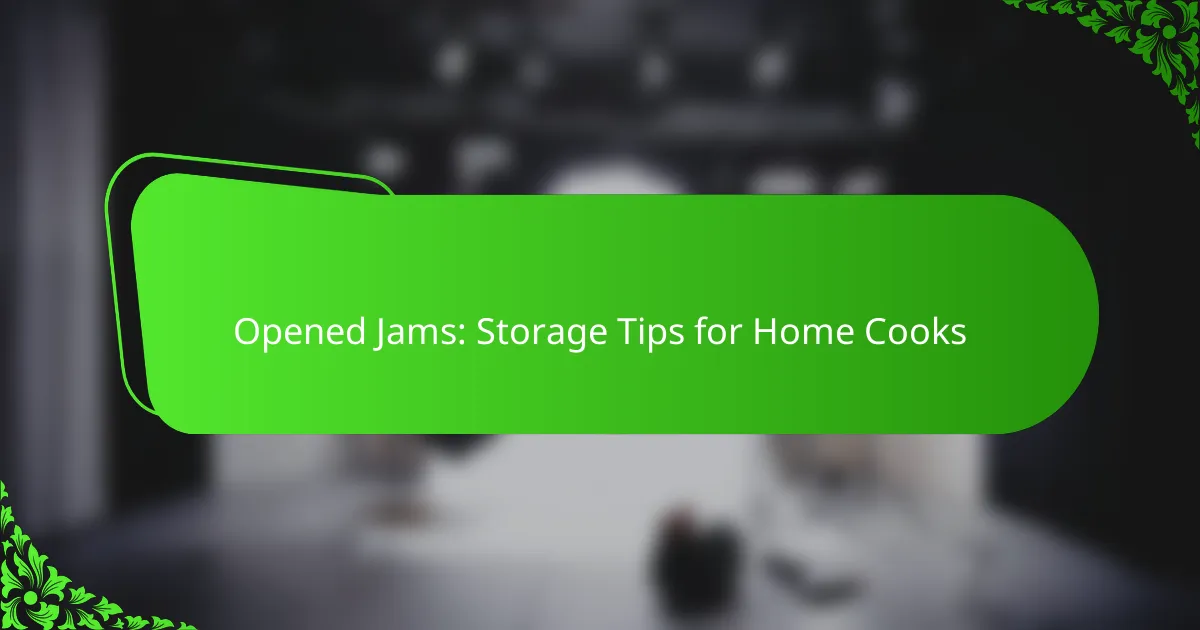Canning jams at home can be a rewarding experience, but it’s crucial to prioritize safety to ensure your preserves are safe to eat. Essential measures include proper sterilization, adhering to processing times, and using tested recipes. By maintaining a clean workspace and ensuring jar seals are intact, you can prevent spoilage and foodborne illnesses, allowing you to enjoy your homemade creations with confidence.

What are the essential safety measures for canning jams?
Essential safety measures for canning jams include proper sterilization, adhering to processing times, ensuring jar seals are intact, maintaining a clean workspace, and using tested recipes. These practices help prevent spoilage and foodborne illnesses, ensuring that your homemade jams are safe to consume.
Use proper sterilization techniques
Proper sterilization techniques are crucial for canning jams to eliminate harmful bacteria. Start by washing jars and lids in hot, soapy water, then rinse thoroughly. Sterilize jars by placing them in a boiling water bath for about 10 minutes or running them through a dishwasher on a hot cycle.
Additionally, keep your utensils and work surfaces clean to avoid contamination. Using sterilized equipment minimizes the risk of spoilage and extends the shelf life of your jams.
Follow recommended processing times
Following recommended processing times is vital to ensure that jams are safely preserved. Each recipe typically provides specific processing times based on the type of fruit and the jar size. Generally, processing times can range from 5 to 15 minutes in a boiling water bath.
Using a timer and adhering to these guidelines helps achieve the right temperature to kill off pathogens. Failing to process for the recommended duration can result in unsafe products.
Check for jar seal integrity
After canning, checking for jar seal integrity is essential to confirm that your jams are properly sealed. A good seal is indicated by a concave lid that does not flex when pressed. If the lid pops back, the jar did not seal correctly.
Sealed jars can be stored at room temperature, while unsealed jars should be refrigerated and consumed quickly. Regularly inspect your jars for signs of spoilage, such as bulging lids or off smells.
Maintain clean work environment
A clean work environment is critical when canning jams to prevent contamination. Before starting, thoroughly clean your countertops, cutting boards, and any tools you will use. Keep pets and unnecessary items out of the kitchen during the canning process.
Washing your hands frequently and wearing clean clothing can further reduce the risk of introducing bacteria into your jars. A tidy workspace promotes safety and efficiency in your canning efforts.
Use tested recipes
Using tested recipes is fundamental for safe canning practices. Recipes from reputable sources, such as the USDA or established canning organizations, ensure that the proportions of ingredients and processing times are safe. Avoid using old family recipes that may not meet current safety standards.
These tested recipes are designed to create the right acidity levels, which are crucial for preventing the growth of harmful bacteria. Stick to these guidelines to ensure your jams are both delicious and safe to eat.

How can I prevent spoilage in home-canned jams?
To prevent spoilage in home-canned jams, focus on proper storage, filling techniques, and sugar content. These factors significantly influence the shelf life and safety of your preserves.
Store jars in cool, dark places
Storing jars in cool, dark places helps maintain the quality of your canned jams. Ideal storage temperatures are typically between 10°C and 21°C (50°F and 70°F), away from direct sunlight and heat sources.
Consider using a pantry or a cellar for optimal conditions. Avoid areas like kitchens where temperature fluctuations are common, as this can lead to spoilage.
Avoid overfilling jars
Overfilling jars can lead to improper sealing and increased spoilage risk. Leave about 1/4 inch (0.6 cm) of headspace at the top of each jar to allow for expansion during processing and to ensure a proper seal.
Check your jars after processing to ensure they have sealed correctly. If any jars are overfilled and do not seal, refrigerate them immediately and use within a few weeks.
Use appropriate sugar levels
Using the right sugar levels is crucial for preventing spoilage in jams. Sugar acts as a preservative, so follow recipes that specify the correct amount, typically around 50-70% of the fruit weight.
Be cautious with low-sugar or no-sugar recipes, as these may require additional preservatives or pectin to ensure safety and shelf stability. Always refer to reliable canning guides for specific sugar recommendations.

What equipment do I need for safe canning?
To ensure safe canning, you need specific equipment that prevents spoilage and maintains food safety. Essential items include canners, jars, and various tools designed for handling hot materials.
Canner types: water bath vs. pressure canner
There are two main types of canners: water bath canners and pressure canners. Water bath canners are suitable for high-acid foods like jams and jellies, while pressure canners are necessary for low-acid foods such as vegetables and meats to prevent botulism.
When choosing between them, consider the types of foods you plan to preserve. Water bath canning is simpler and requires less equipment, but pressure canning is essential for safely preserving a wider variety of foods.
Essential tools: jar lifter, funnel, and thermometer
Key tools for safe canning include a jar lifter, funnel, and thermometer. A jar lifter helps you safely remove hot jars from the canner, reducing the risk of burns or spills.
A funnel is crucial for filling jars without mess, ensuring that you maintain the proper headspace for sealing. A thermometer is important for checking the temperature of your canner, especially when using a pressure canner, to ensure that the food is processed at the correct temperature for safety.

What are the common mistakes in jam canning?
Common mistakes in jam canning can lead to spoilage or unsafe products. Awareness of these pitfalls is essential for successful home preservation.
Ignoring altitude adjustments
Altitude can significantly affect the canning process, particularly the boiling point of water. At higher elevations, water boils at lower temperatures, which can impact the safety and quality of your jam.
To ensure safety, adjust processing times based on your altitude. For example, if you are canning at an elevation above 1,000 feet, you may need to increase processing times by 5 to 10 minutes for every additional 1,000 feet.
Using non-canning jars
Using jars not specifically designed for canning can lead to breakage or seal failure. Regular glass jars may not withstand the heat and pressure of the canning process.
Always use jars labeled for canning, such as Mason jars. These are designed to create a vacuum seal and withstand the high temperatures required for safe preservation.
Not checking pH levels
pH levels are crucial in jam making, as they determine the acidity of the product. A low pH is necessary to prevent the growth of harmful bacteria, such as botulism.
Use a pH meter or pH test strips to ensure your jam has a pH of 4.6 or lower. If your jam is too high in pH, consider adding more acidic ingredients like lemon juice or citric acid to ensure safety.

How do I choose the right fruit for canning jams?
Choosing the right fruit for canning jams is crucial for flavor and preservation. Opt for fresh, ripe fruit that is free from blemishes to ensure the best quality jam.
Select ripe, high-quality fruit
Ripe fruit is essential for making delicious jams. Look for fruit that is firm, fragrant, and has vibrant color. Avoid any fruit that shows signs of overripeness or decay, as this can affect the taste and texture of your jam.
Common fruits for canning include strawberries, blueberries, raspberries, and peaches. Each fruit has its peak season, so selecting high-quality options during this time will yield the best results.
Consider seasonal availability
Seasonal availability plays a significant role in fruit selection for canning jams. Using fruit that is in season not only ensures better flavor but also often results in lower prices. For example, strawberries are typically in season from late spring to early summer, while apples are available in the fall.
Check local farmers’ markets or grocery stores for seasonal produce. This not only supports local agriculture but also guarantees fresher fruit for your canning projects.

What are the best practices for labeling canned jams?
Labeling canned jams correctly is essential for ensuring safety and quality. Clear labels help identify the contents and the date of preservation, which is crucial for monitoring freshness and preventing spoilage.
Include date and contents
Each label should clearly state the date of canning and the specific contents of the jar. This practice helps you track how long the jam has been stored and ensures you know what flavors you have on hand. For example, a label might read “Strawberry Jam – Canned on 2023-09-15.”
Consider using a consistent format for all your labels. This could include the type of fruit, any added ingredients, and the canning date. Keeping this information uniform makes it easier to manage your pantry and prioritize consumption.
Use waterproof labels
Waterproof labels are crucial for preserving the integrity of your information. Canned jams are often stored in moist environments, and regular paper labels can easily smudge or peel off. Opt for labels made from synthetic materials or those specifically designed to withstand moisture.
Additionally, ensure that the adhesive used on the labels is strong enough to withstand temperature changes and humidity. This will help maintain clear visibility of the contents and date, reducing the risk of confusion or spoilage.

What are the signs of unsafe canned jams?
Unsafe canned jams can exhibit several signs that indicate spoilage or contamination. Common indicators include unusual odors, mold growth, and bulging lids, which suggest that the jam may harbor harmful bacteria or toxins.
Unusual odors
If a canned jam has a sour, off, or otherwise strange smell, it is likely unsafe to consume. Freshly canned jams should have a pleasant, fruity aroma. Any deviation from this can signal spoilage.
Mold growth
Mold on the surface of canned jams is a clear sign of spoilage. Even if the mold is removed, the jam may still contain harmful bacteria. It is best to discard any jam that shows visible mold.
Bulging lids
A bulging lid on a jar of canned jam indicates that gas is being produced inside, often due to fermentation or bacterial growth. This is a serious warning sign, and the jam should not be consumed. Always check the integrity of the lid before opening.
Separation or unusual texture
If the jam appears separated or has an unusual texture, it may not be safe. Properly canned jams should have a consistent texture and appearance. Any significant changes can indicate spoilage.
Expiration date
Always check the expiration date or the recommended shelf life of your canned jams. While properly canned jams can last for a year or more, consuming them past their expiration date increases the risk of spoilage and foodborne illness.










